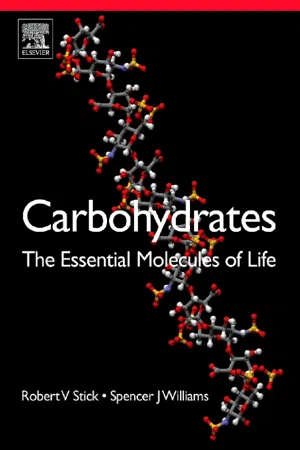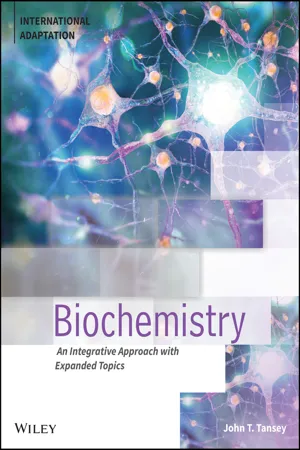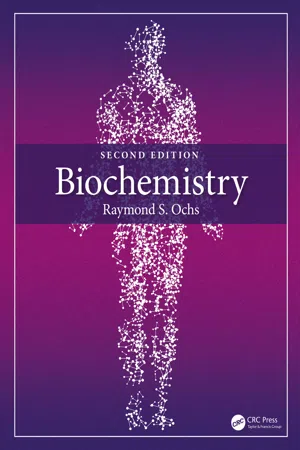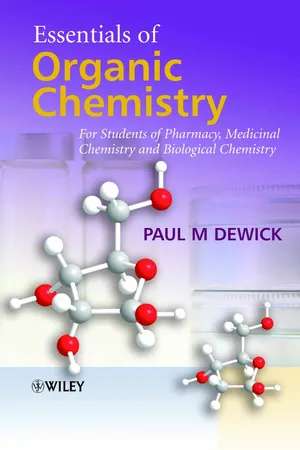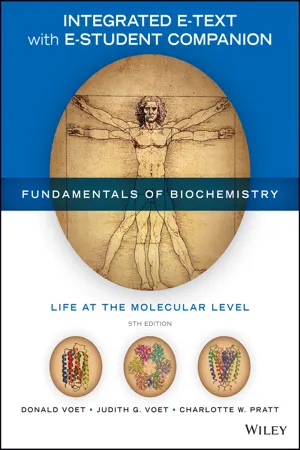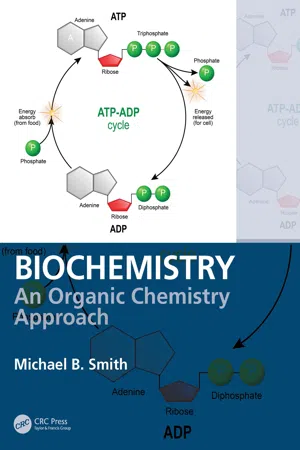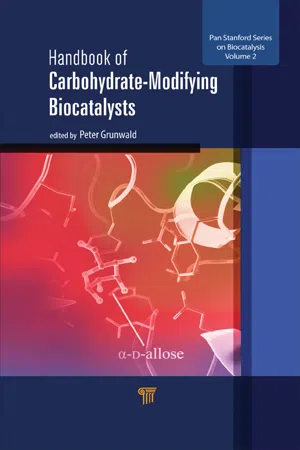Chemistry
Reactions of Monosaccharides
Monosaccharides undergo various reactions, including oxidation, reduction, and glycosidic bond formation. Oxidation of monosaccharides can lead to the formation of sugar acids or sugar alcohols, while reduction can yield sugar alcohols. Glycosidic bond formation involves the linkage of monosaccharides to form disaccharides or polysaccharides. These reactions play a crucial role in the synthesis and breakdown of carbohydrates.
Written by Perlego with AI-assistance
Related key terms
Related key terms
1 of 4
Related key terms
1 of 3
12 Key excerpts on "Reactions of Monosaccharides"
- eBook - ePub
- Robert V. Stick, Spencer Williams(Authors)
- 2010(Publication Date)
- Elsevier Science(Publisher)
1 ]So far, most of the chemical transformations of a monosaccharide discussed in this book have been concerned with the concept of protecting groups. In general, the order of reactivity of the various hydroxyl groups of d-glucopyranose was observed to be O1 (hemiacetal) > O6 (primary) > O2 (adjacent to C1 and therefore more acidic) > O3 > O4; this order, of course, is dictated very much by the nature of the substrate and the reagent, as well as whether an O–H or a C–O bond is being broken. Now, a host of chemical reactions will be discussed that cause functional group transformations within monosaccharides, either for the purpose of elaboration into oligosaccharides or for the synthesis of a derivative of the monosaccharide. Such derivatives include the deoxy and amino deoxy sugars.By the nature of the subject, this discussion will be neither exhaustive nor all-inclusive. It will, however, highlight the methods that work well in synthetic carbohydrate chemistry, particularly those that have evolved over the last few decades.Oxidation
[2–6 ]We have already seen the importance of oxidation to the German chemists of the nineteenth century. Aldoses were oxidized to aldonic acids using bromine water and to aldaric acids using dilute nitric acid; these reagents are still used today.The major advances have been concerned with the discovery or ‘invention’, as some have called it,[a ]of chemoselective reagents for oxidation of the various hydroxyl groups within a carbohydrate. The well-established Jones’ (CrO3 , H2 SO4 )[8 ]and Collins’ (CrO3 , pyridine)[9 ]reagents soon gave way to milder and more easily handled oxidizing agents, namely pyridinium chlorochromate[10 ]and pyridinium dichromate.[11,12 - eBook - ePub
Biochemistry
An Integrative Approach with Expanded Topics
- John T. Tansey(Author)
- 2022(Publication Date)
- Wiley(Publisher)
G ° values close to zero can be tipped to move in either direction by changing the concentrations of substrates or products.• The synthesis of glucose and the degradation of monosaccharides use similar reactions but different pathways. Key steps are different, and compartmentalization is important. A similar theme is seen in fatty acid metabolism.6.1 Properties, Nomenclature, and Biological Functions of MonosaccharidesCarbohydrates are a group of biological molecules with the basic formula Cx (H2 O)x , hence the name “carbo-hydrate.” At their most basic level, carbohydrates have the equivalent of one molecule of water for every carbon atom. This means that carbohydrates are polyhydroxy aldehydes or polyhydroxy ketones, that is, molecules in which one carbon bears a carbonyl group (C=O) and the others all carry hydroxyls ( −OH) . They also contain at least three carbons. We will first discuss the basic structures of carbohydrates and different ways we can represent these molecules on paper, and then we will move into modifications of these molecules.6.1.1 Monosaccharides are the simplest carbohydratesThis section focuses on the simplest carbohydrates, the monosaccharides . Monosaccharides can be linked together to form more complex carbohydrates. Monosaccharides all end in the suffix -ose to designate them as carbohydrates. They can be classified based by the number of carbons in the molecule, the presence of an aldehyde or a ketone, and the stereochemistry at the penultimate carbon (the chiral center farthest from the carbonyl). In terms of size, monosaccharides contain three to nine carbons but most contain five, six, or seven carbons (Table 6.1 ). The reasons for this are rooted in organic chemistry. A numbering system can be combined with the “-ose” suffix to provide a generic name for a group of carbohydrates; for example, five-carbon monosaccharides are pentoses and six-carbon monosaccharides are hexoses . Thanks to the carbonyl moiety, a monosaccharide contains either an aldehyde or a ketone and can therefore be broadly categorized as aldoses or ketoses - eBook - ePub
Carbohydrate Chemistry and Biochemistry
Structure and Mechanism
- Michael Sinnott(Author)
- 2023(Publication Date)
- Royal Society of Chemistry(Publisher)
CHAPTER 1 Structures of Open-chain Forms of Reducing Sugars and Related Molecules. Mechanistic Probes of Sugar Carbonyl Group Additions1.1 DEFINITIONS AND STRUCTURES
1.1.1 Definitions
Historically, carbohydrates were defined as substances with the empirical formula Cn (H2 O)m . The common sugars such as glucose and fructose (n =m =6), or sucrose (n =12, m =11) fit this formula, but nowadays the convention is to regard as a carbohydrate a polyhydroxy aldehyde or polyhydroxy ketone with the classical formula, a molecule closely related to it, or oligomers or polymers of such molecules. Their study evolved as a separate sub-discipline within organic chemistry for practical reasons – they are water-soluble and difficult to crystallise – so that their manipulation demanded different sets of skills from classical “natural products” such as terpenes, steroids, alkaloids, etc.The term “monosaccharide” refers to a carbohydrate derivative possessing a single carbon chain; “disaccharide” and “trisaccharide” refer to molecules containing two or three such monosaccharide units joined together by acetal or ketal linkages. “Oligosaccharide” and “polysaccharide” refer to larger such aggregates, with “a few” and “many” monosaccharide units, respectively. Current usage seems to draw the distinction between “few” and “many” at around 10 sugar units.The everyday term “sugar” is used to describe mono-, di-, and the lower oligosaccharides, particularly when unprotected. The historical term “reducing sugar” is still useful to describe a carbohydrate with a free carbonyl group, or one masked only by internal hemiacetal or hemiketal formation. The term arose because nineteenth-century physiologists and chemists had to rely on colour reactions, many of which are now known to involve single-electron transfers to transition metal complexes (e.g. Fehling's solution, CuII –tartrate complexes). Colour changes are observed if an ene diol structure (R-CH(OH) CH(OH)-R′ ) or similar can be formed under the conditions of the test, since its anion readily loses an electron to form a resonance-stabilised radical.1 - eBook - ePub
Food Carbohydrates
Chemistry, Physical Properties, and Applications
- Steve W. Cui, Steve W. Cui(Authors)
- 2005(Publication Date)
- CRC Press(Publisher)
Understanding the Chemistry of Food CarbohydratesMarta IzydorczykCONTENTS- 1.1 Introduction
- 1.2 Monosaccharides
- 1.2.1 Basic Structure of Monosaccharides
- 1.2.2 Ring Forms of Sugars
- 1.2.3 Stereochemical Transformations
- 1.2.3.1 Mutarotation
- 1.2.3.2 Enolization and Isomerization
- 1.2.4 Conformation of Monosaccharides
- 1.2.4.1 Conformation of the Pyranose Ring
- 1.2.4.2 Conformation of the Furanose Ring
- 1.2.4.3 Determination of Favored Pyranoid Conformation
- 1.2.5 Occurrence of Monosaccharides
- 1.3 Oligosaccharides
- 1.3.1 Formation of Glycosidic Linkage
- 1.3.2 Disaccharides
- 1.3.3 Conformation of Disaccharides
- 1.3.4 Oligosaccharides
- 1.3.5 Cyclic Oligosaccharides
- 1.4 Reaction of Monosaccharides and Derived Carbohydrate Structures
- 1.4.1 Oxidation and Reduction Reactions
- 1.4.2 Deoxy and Amino Sugars
- 1.4.3 Sugar Esters and Ethers
- 1.4.4 Glycosides
- 1.4.5 Browning Reactions
- 1.4.5.1 Maillard Reaction
- 1.4.5.2 Caramelization
- 1.5 Polysaccharides
- 1.5.1 General Structures and Classifications
- 1.5.2 Factors Affecting Extractability and Solubility of Polysaccharides
- 1.5.3 Extraction of Polysaccharides
- 1.5.4 Purification and Fractionation of Polysaccharides
- 1.5.5 Criteria of Purity
- References
1.1 Introduction
Carbohydrates are the most abundant and diverse class of organic compounds occurring in nature. They are also one of the most versatile materials available and therefore, it is not surprising that carbohydrate-related technologies have played a critical role in the development of new products ranging from foods, nutraceuticals, pharmaceuticals, textiles, paper, and biodegradable packaging materials.1 - Sabyasachi Maiti, Sougata Jana(Authors)
- 2019(Publication Date)
- Woodhead Publishing(Publisher)
22 ]. In order to understand the various biomedical and biochemical processes at the molecular level, the short discussion on biosynthesis and degradation of polysaccharides, including the chemical transformation involved in these processes, is necessary to a great extent. Even more, starting from the biosynthesis of monosaccharides and moving to oligosaccharides and polysaccharides is truly significant to all researchers for a better understanding of the fundamental polysaccharide chemistry and their long-standing applications in various fields.1.2.1 Monosaccharides
In nature, the most frequently encountered carbohydrate units as monosaccharides are: hexoses (six-carbon sugar) and pentoses (five-carbon sugar). Photosynthesis produces a three-carbon-based sugar molecule, which is named 3-phosphoglyceraldehyde [24] . Two molecules of 3-phosphoglyceraldehydes turn into six-carbon sugar, glucose 6-phosphote, effectively via reverse glycolytic pathway. In contrast, 3-phosphoglyceraldehydes can be utilized in the Calvin cycle to access five-carbon pentose sugars, such as ribose 5-phosphate, ribulose 5-phosphate, and xylulose 5-phosphate. The fundamental chemical reactions, such as mutation, epimerization, aldose-ketose interconversions, chain-shortening and chain-elongation modification, and oxidation-reduction including transamination steps, can be used in the biochemical manipulation of monosaccharide structure [25 , 26] . Reversible transfer of 2-C “active glycoaldehyde” fragment from a ketose donor (d -xylulose-5-phosphate) to an aldose acceptor (d -ribose-5-phosphate) catalyzed by transketolase enzyme (Thiamine pyrophosphate is the active catalyst) generates d -glyceraldehyde 3-P (chain-shortening) and d- eBook - ePub
- V. S. R. Rao(Author)
- 2019(Publication Date)
- CRC Press(Publisher)
The twentieth century has witnessed the greatest growth in the structure determination of biopolymers and hence increased our understanding of these biomolecules. The versatile properties of carbohydrates are fully commensurate with a diverse array of molecules that can be generated from a limited number of monosaccharides as building blocks by linking them in a variety of ways. Thus, a basic knowledge of the chemical structure of carbohydrates is essential towards the development of conformational analysis and visualization of the geometries of complex carbohydrates.1.2 Classification
Derived from the Latin word saccharum for sugar, which itself has its origin in the Sanskrit word sarkhara, carbohydrates are commonly classified as monosaccharides, disaccharides, trisaccharides, oligosaccharides and polysaccharides. A monosaccharide is defined as that unit which cannot be further hydrolyzed into smaller carbohydrates. A disaccharide, as the name implies, can be hydrolyzed into two monosaccharides. Similarly, tri-, tetra- and penta-saccharides on hydrolysis give 3,4 and 5 monosaccharides, respectively. Generally, the term oligosaccharide (from oligos, Greek for few) is used to describe a molecule that contains 10 to 20 monosaccharides and the term polysaccharide is reserved to describe a large carbohydrate molecule.Carbohydrates are often found covalently linked to other biomolecules such as proteins (glycoproteins and proteoglycans) and lipids (glycolipids and lipopolysaccharides). To distinguish these molecules from pure carbohydrates, they are collectively called “glycoconjugates.”1.3 Simple Monosaccharides
Monosaccharides are generally represented by the empirical formula Cn H2n On or Cn .(H2 O)n . The latter representation led to the belief that they are hydrates of carbon, and so this family of compounds came to be called “carbohydrates.” The carbon skeleton of acyclic monosaccharides is unbranched and a hydroxyl group is attached to each carbon except for the one which carries the carbonyl oxygen (Figure 1.1 ). Hence, these molecules are more appropriately known as “polyhydroxyaldoses” or “polyhydroxyketoses” (or simply, aldoses or ketoses) depending on the position of the carbonyl group. In aldoses, the carbonyl group is at one end of the chain, whereas in ketoses it can be in any position except at the end. Ketoses are further classified as 2-ketoses, 3-ketoses, etc - eBook - ePub
- Raymond S. Ochs(Author)
- 2021(Publication Date)
- CRC Press(Publisher)
Disaccharides – or any sugar polymer – in our diet must be hydrolyzed to monosaccharides prior to entering the cells lining the small intestine. The reaction is catalyzed by enzymes positioned extracellularly and specific to each digestible disaccharide: i.e., sucrase is required to hydrolyze the glycosidic bond of sucrose, and lactase is required to hydrolyze that of lactose. In some cases, this process is impaired, leading to digestive disorders (Box 4.3).In the disaccharides of Figure 4.9 , one of the sugar units is glucose; the other is glucose, galactose, or fructose. When just one anomeric carbon is involved in glycoside formation, as in maltose and lactose, a free anomeric carbon remains in equilibrium with an open-chain form (see Figure 4.10 for maltose). Even a small amount of this open-chain form in solution allows the carbonyl group to cause the reduction of metal ions in diagnostic tests. The positive result in this experimental test indicates the presence of a reducing sugar. Thus, all monosaccharides are reducing sugars; of the disaccharides displayed in Figure 4.9 , maltose and lactose are reducing sugars, while sucrose and trehalose are nonreducing sugars. An exploration of the term reducing is presented in Box 4.4.4.4 Polysaccharides
When more than two sugars are linked via glycosidic bonds, they are said to be either oligosaccharides (meaning “a few”) or polysaccharides (meaning “many”). The distinction is inexact: some consider chains of up to ten linked sugars to be oligosaccharides. Commonly, polysaccharides have thousands of monosaccharide residues bound together. Such molecules have extremely large molecular weights and have new properties not found in smaller molecules. In general, large molecules that are constructed from small units are called polymers - eBook - ePub
Essentials of Organic Chemistry
For Students of Pharmacy, Medicinal Chemistry and Biological Chemistry
- Paul M. Dewick(Author)
- 2013(Publication Date)
- Wiley(Publisher)
12
Carbohydrates
12.1 Carbohydrates
Many aspects of the chemistry of carbohydrates are not specific to this class of compounds, but are merely examples of the simple chemical reactions we have already met. Therefore, against usual practice, we have not attempted a full treatment of carbohydrate chemistry and biochemistry in this chapter. We want to avoid giving the impression that the reactions described here are something special to this group of compounds. Instead, we have deliberately used carbohydrates as examples of reactions in earlier chapters, and you will find suitable cross-references.Carbohydrates are among the most abundant constituents of plants, animals, and microorganisms. Polymeric carbohydrates function as important food reserves, and as structural components in cell walls. Animals and most microorganisms are dependent upon the carbohydrates produced by plants for their very existence. Carbohydrates are the first products formed in photosynthesis, and are the products from which plants synthesize their own food reserves, as well as other chemical constituents. These materials then become the foodstuffs of other organisms. The main pathways of carbohydrate biosynthesis and degradation comprise an important component of intermediary metabolism that is essential for all organisms (Chapter 15).The name carbohydrate was introduced because many of the compounds had the general formulaCx(H2 O)y , and thus appeared to be hydrates of carbon. The terminology is now commonly used in a much broader sense to denote polyhydroxy aldehydes and ketones, and their derivatives. Sugars or saccharides are other terms used in a rather broad sense to cover carbohydrate materials. Though these words link directly to compounds with sweetening properties, application of the terms extends considerably beyond this. A monosaccharide is a carbohydrate usually in the range C3 –C9, whereas oligosaccharide covers small polymers comprised of 2–10 monosaccharide units. The term polysaccharide - eBook - ePub
Fundamentals of Biochemistry, Integrated E-Text with E-Student Companion
Life at the Molecular Level
- Donald Voet, Judith G. Voet, Charlotte W. Pratt(Authors)
- 2017(Publication Date)
- Wiley(Publisher)
Until the 1960s, carbohydrates were thought to have only passive roles as energy sources (e.g., glucose and starch) and as structural materials (e.g., cellulose). Carbohydrates, as we will see, do not catalyze complex chemical reactions as do proteins, nor do carbohydrates replicate themselves as do nucleic acids. And because polysaccharides are not built according to a genetic “blueprint,” as are nucleic acids and proteins, they tend to be much more heterogeneous—both in size and in composition—than other biological molecules.However, it has become clear that the innate structural variation in carbohydrates is fundamental to their biological activity. The apparently haphazard arrangements of carbohydrates on proteins and on the surfaces of cells are the key to many recognition events between proteins and between cells. An understanding of carbohydrate structure, from the simplest monosaccharides to the most complex branched polysaccharides, is essential for appreciating the varied functions of carbohydrates in biological systems.1 Monosaccharides
KEY CONCEPTS
- The smallest sugars are aldoses or ketoses, with the formula (C · H2 O)n.
- Monosaccharides cyclize to form α or β anomers.
- The derivatives of monosaccharides include the aldonic acids, uronic acids, alditols, deoxy sugars, and amino sugars.
- Monosaccharides can be linked to each other or to other molecules by glycosidic bonds.
A Monosaccharides Are Aldoses or Ketoses
Monosaccharides are aldehyde or ketone derivatives of straight-chain polyhydroxy alcohols containing at least three carbon atoms. They are classified according to the chemical nature of their carbonyl group and the number of their C atoms. If the carbonyl group is an aldehyde, the sugar is analdose. If the carbonyl group is a ketone, the sugar is aketose. The smallest monosaccharides, those with three carbon atoms, are trioses. Those with four, five, six, seven, etc. C atoms are, respectively, tetroses, pentoses, hexoses, heptoses - eBook - ePub
Biochemistry
An Organic Chemistry Approach
- Michael B. Smith(Author)
- 2020(Publication Date)
- CRC Press(Publisher)
p .For polysaccharides, even the shorthand notation is unwieldy. Most of these compounds are given common names, and since they are usually polymeric, the repeating monosaccharide or disaccharide units are often shown. Many of these are homopolymers , that is the poly(saccharide) is formed by coupling only one monosaccharide unit. Cellulose , for example, is a linear poly(glucopyranose), coupled in a (1⟶4)-β-d- manner, as shown, and it is a major constituent of plant cell walls. Amylose (a constituent of starch) is a linear poly(glucopyranose) coupled (1⟶4)-α-d-.14.3 Reactions of Carbohydrates
Reactions of carbohydrates are closely related to the normal reactions of alcohols, aldehydes, and ketones seen in previous chapters. The presence of multiple functional groups is problematic, however, because one group may interact with another. The formation of furanose and pyranose rings in the previous sections via a hemiacetal or a hemiketal reaction and of disaccharides via an acetal or a ketal reaction is one example where the functional groups interact with each other. There are many other reactions where the hydroxyl units behave independently, or where the aldehyde or ketone unit behaves independently. This section will explore several fundamental carbohydrate reactions.A discussion of reactions will begin by introducing another classification scheme for carbohydrates. There are reducing sugars and nonreducing sugars . These sugars are generally categorized by whether or not they react with Fehling’s solution [heating in aqueous copper (II) sulfate and sodium tartrate] or with Tollens’ solution (silver nitrate in ammonia). Fehling’s solution reacts with α-hydroxyaldehydes, α-hydroxyketones and α-ketoaldehydes, so carbohydrates with these structural features will reduce the Cu(II) to Cu(I) oxide, a red-brown solid. Due to mutarotation (Section 13.3), a carbohydrate has an aldehyde unit in equilibrium with the furanose or pyranose isomers, so they react with these reagents, which oxidize the aldehyde to a carbonyl compound. Carbohydrates that react with Fehling’s or Tollens’ reagent are known as reducing sugars - eBook - ePub
- Peter Grunwald, Peter Grunwald(Authors)
- 2016(Publication Date)
- Jenny Stanford Publishing(Publisher)
Section 1.4 .Handbook of Carbohydrate-Modifying Biocatalysts Edited by Peter Grunwald Copyright © 2016 Pan Stanford Publishing Pte. Ltd. ISBN 978-981-4669-78-8 (Hardcover), 978-981-4669-79-5 (eBook) www.panstanford.com1.2 Classification of Carbohydrates
Basically, two different systematic approaches can be used for a classification of carbohydrates: as carbohydrates either contain hydroxy and aldehyde functions (see Fig. 1.1a , glucose) or, alternatively, hydroxy and ketone functions (Fig. 1.1b , fructose), this discrimination may form a basis for a classification. Another approach that is often being used in basic monographs is based on the systematic discrimination between monosaccharides, disaccharides, oligosaccharides and polysaccharides. In the present chapter, both approaches will be combined by including the functional aspects in the sub-chapter mono-saccharides. As the terms suggest, mono- and di-saccharides consist of one and two sugar units, respectively, while oligosaccharides are assumed to contain 3 to 10 subunits linked together (according to the Greek word oligos, for “a few”). Polysaccharides contain more than 10 subunits.1.2.1 MonosaccharidesThe early constitutional as well as stereochemical investigations are closely related to the names Emil Fischer, Kiliani, and Tollens (Lichtenthaler, 1992). It was inferred from these basic results that monosaccharides can be considered to be oxidation products of alcohols that contain several hydroxy groups, resulting in polyhydroxy aldehydes or polyhydroxy ketones. The former group of oxidation products is nominated aldoses, while the latter group is called ketoses. - eBook - ePub
- James N. BeMiller(Author)
- 2018(Publication Date)
1Monosaccharides
Abstract
In addition to background information on carbohydrates in nature and in our food, this chapter describes monosaccharides related to foods that are open chain and pyranose and furanose ring structures, nomenclature of monosaccharides, isomerization of aldoses and ketoses, formation and hydrolysis of glycosides, and some functions of monosaccharides in foods.Keywords
Aldose; Deoxy sugar; Dextrose; Fructose; Furanose ring; Glucose; Glycoside; Glycosidic bond; Hexose; Ketose; Monosaccharide; Pentose; Pyranose ringChapter Outline- Introduction
- Structures and nomenclature
- Isomerization
- Ring forms
- Glycosides
- Other types of monosaccharides
- Some functions of monosaccharides in foods
- Additional resources
Key information and skills that can be obtained from study of this chapter will enable you to:- 1. Define and/or identify
chiral carbon atom furanose ring monosaccharide anomeric carbon atom saccharose group anomers dextrose axial positions aldose equatorial positions acyclic glycoside D sugar glycosidic bond L sugar aglycon ketose deoxy sugar pyranose ring hygroscopic Haworth projection humectant - 2. Identify and/or describe monosaccharides as to the kind of carbonyl group and number of carbon atoms (for example, aldotetrose, octulose, etc.).
- 3. Give Fischer and specific anomeric furanose and pyranose ring structures (Haworth projections) for the following: L -arabinose, D -xylose, D -galactose, D -glucose, D -mannose, D -fructose.
- 4. Make interconversions between names, acyclic structures, Haworth ring structures, and/or conformational ring structures of the sugars listed in objective 3.
- 5. Describe the chemical properties of hemiacetals and acetals.
- 6. Show the interrelationships of D -glucose, D -mannose, and D -fructose via isomerization.
- 7. Describe the conditions under which isomerization occurs.
- 8. When given the name of a glycoside of a sugar listed in objective 3 (for example, ethyl β-D
Index pages curate the most relevant extracts from our library of academic textbooks. They’ve been created using an in-house natural language model (NLM), each adding context and meaning to key research topics.
Explore more topic indexes
Explore more topic indexes
1 of 6
Explore more topic indexes
1 of 4
